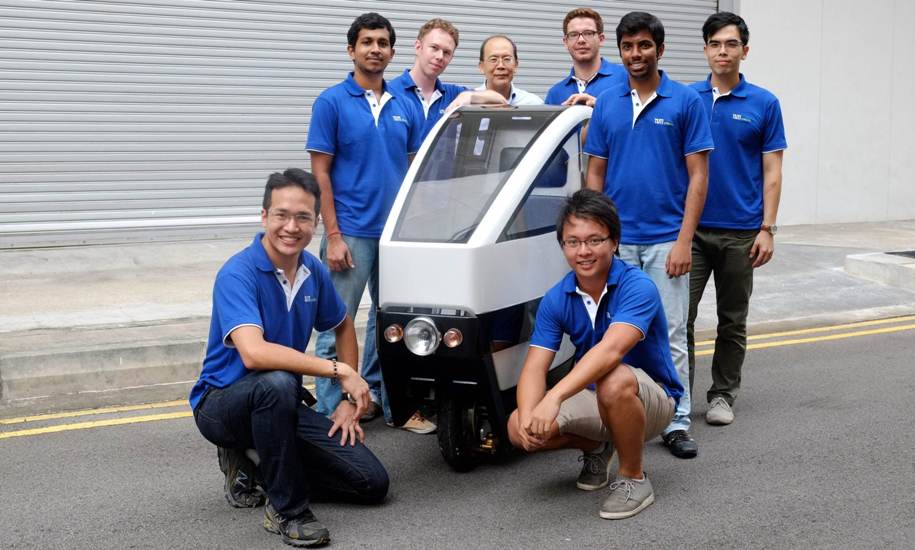VOI

Overview
Traffic congestion is
a major problem in densely populated megacities such as Jakarta, travelling from
point A to B is very inconvenient especially for the working class. Regular
taxis are comfortable, but run the risk of being completely held up by the
traffic congestion. Two-wheelers while able to weave through traffic and reach
their destination faster; do not offer the same level of comfort and
environmental protection as regular taxis. A vehicle combining both safety and
comfort of a car with the agility of a two-wheeler would therefore be very
beneficial, but is currently not readily available.
MAE and TUM
(Technical University of Munich) students jointly develops ‘VOI’ or elephant in
Vietnamese which signifies safety, ecological friendliness and comfort. Equipped
with a front passenger pod, the electric powered two-wheeler serves as personal
transporter or taxi, allowing the passenger a speedy commute through heavy
traffic while shielded from the elements. When needed, the passenger pod can be
swapped for a cargo carrier or mobile food stand.
Awards and Achievements
VOI team won the Land Transport Excellence Award 2014 in the “Young Innovator” category during the biannual award ceremony on 17th April 2014. This award recognizes the individual/s who has delivered innovative products or services resulting in land transport transformation. Land Transport Authority (LTA) launched the inaugural Land Transport Excellence Awards in 2008 to celebrate the best in the land transport industry who demonstrate commitment and dedication towards Singapore's vision of a people-centered land transport system.
Specifications

Dimensions | 2320 x 710 x 1320 mm |
People | 1 Driver + 1 Passenger |
Payload | Hand Luggage |
Range | 80 km |
Max. Speed | 45 km/h |
Power | 2.5 kW |
Curb Weight | 145 kg |
Cruising Speed | 70km/h |
Max speed | 130km/h |
Design
The anthropologic dimensions of Singaporeans and Indonesians are used to determine the package. Thus 95th percentile of Indonesian men (1.83 m) is considered as the tallest allowable passenger sitting in the cabin.
Prototyping

The passenger cabin is made of CFRP, allowing a light and very stiff monocoque. In order to achieve a comfortable entrance and exit for the passenger, the module employs a front-flip mechanism, hinged on the front, which enables the entire enclosed structure to be lifted up.
Energy Storage

The 48 V battery box includes 13 battery modules with 20 Panasonic lithium NCR 18650A cells each and has a capacity of 3 kWh. Thermal measurements have been carried out to investigate the heat transmission that occurs during the discharging process.
Conclusion
The presented features, amongst others, will lead to a vehicle perfectly fitted in developing tropical megacities. VOI aims to be able to take passengers as well as cargo quickly and safely though the traffic with its short wheelbase and ability to transport heavy loads. This would fit perfectly in cities like Jakarta. Maintaining the idea provide comparable level of comfort and safety as a car for the passenger, and as agile and economic as a scooter for the driver, VOI aims to provide a novel and interesting experience for both passenger and driver.
Team Members
MAE Project Lead
 | Assoc Professor Ng Heong Wah Division of Engineering Mechanics School of Mechanical and Aerospace Engineering |

Standing: From left to right- Kuganeshan Ganesamoorthy (MAE), Niklas Righi (TUM),
Associate Professor Ng Heong Wah (MAE Project lead), Daniel Ostler (TUM),
Tinagaran Puvanasan (MAE) and Lee Wei Xun Enrique (MAE).
Squatting:From left to right- Witono Halim (TUM CREATE Project officer) and Teo Wei Lun (MAE).
Members not in picture: Stephan Schickram (TUM Project lead), Carolin Suesslack (TUM)
and Sebastian Stadler (TUM)

